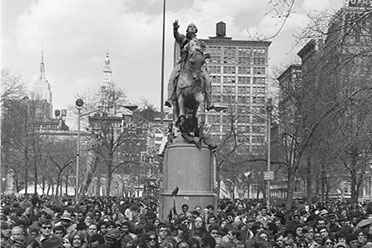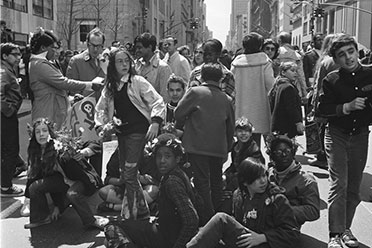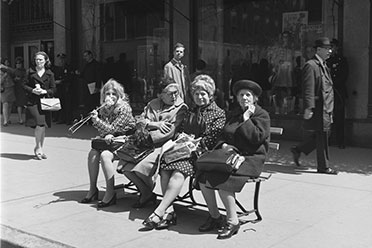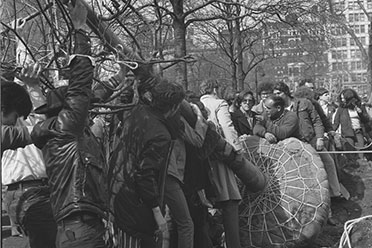History of Earth Day & Arbor Day in Parks
Learn about the history of Earth Day and Arbor Day in our parks and join us at our upcoming Earth Day and Arbor Day events in April!
Earth Day Origins in New York City
Earth Day began in 1970 as a way to raise awareness about environmental issues. Gaylord Nelson, a U.S. Senator from Wisconsin, and Denis Hayes, a young environmentalist, joined to organize events across the country and "shake things up." Following that first Earth Day, which was celebrated by 20 million people across the country, President Richard Nixon created the Environmental Protection Agency.
For the first Earth Day on April 22, 1970, thousands participated in various sanctioned events in New York City. Fifth Avenue was closed to traffic from Union Square Park to Central Park, and 14th Street between 3rd and 7th Avenues was transformed into an "ecological carnival."
Union Square Park served as the focus of numerous Earth Day observances and teach-ins throughout the metropolitan region. Over the day, some 100,000 people were estimated to have thronged to the square in one of the largest demonstrations there since the socialist rallies of the 1930s. The empty streets resulted in at least one picnic spread at the intersection of 57th Street and Fifth Avenue, and Mayor John V. Lindsay repeated the idea during the summer of 1970 when he closed Fifth Avenue to traffic for four successive weekends. The City also banned cars for the day in Central Park in Manhattan, Brooklyn's Prospect Park, Forest Park in Queens, and Silver Lake Park in Staten Island.
Earth Day became a global event in 1990; the event has been celebrated in earnest with tours, events, and volunteer opportunities at parks across the city since 2000. For NYC Parks, Earth Day is a chance to honor our green spaces and how we care for them, and to raise awareness about how we are working to shape a greener future for our city.
Arbor Day Observed in the City
Arbor Day, celebrated on the last Friday in April, dates to 1872 when it is said that over one million trees were planted in Nebraska. Julius Sterling Morton, originally from upstate New York then living in Nebraska, was instrumental in establishing the day. New York State has been celebrating Arbor Day since 1888, and Arbor Day has been celebrated at NYC Parks for years. In 1906, Arbor Day festivities were held in playgrounds, "thereby inculcating a true love for nature," according to the 1906 Annual Report.
Planting Trees for New York City
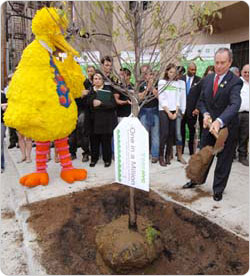 With the support of Big Bird, Mayor Bloomberg helps plant the first tree of the MillionTreesNYC initiative, October 9, 2007. Photo by Daniel Avila.
With the support of Big Bird, Mayor Bloomberg helps plant the first tree of the MillionTreesNYC initiative, October 9, 2007. Photo by Daniel Avila.
Inspired by the million trees planted in Nebraska in 1872, NYC Parks and the New York Restoration Project launched MillionTrees NYC in 2007. The goal of the citywide public-private program was to plant and care for one million new trees across the city. In his support for this tree initiative, Mayor Michael Bloomberg pointed out that trees help clean the air and reduce the pollutants that trigger asthma (an endemic problem in underserved areas of the city) while also cooling streets, sidewalks, and homes on hot days, and increasing property values and encouraging neighborhood revitalization. In 2015, thanks to help from NYRP, additional partners, our many volunteers, and nearly 50,000 New Yorkers who helped plant trees in our parks, on neighborhood streets, and in their own backyards, we planted our millionth tree.
In the last 20 years, Parks has worked to diversify New York City’s street tree species to make our urban forest stronger and more resilient. We currently plant over 200 tree species that are well suited to the urban environment because they’re able to withstand soil compaction, drought, flooding, air pollution, high pH soils, and strong winds. More information can be found on our Approved Species List page, the NYC Street Tree Map, and our 2015 Street Tree Census Report.
